|
Lößnitz (Ore Mountains)
Bergstadt Lößnitz (“Mining Town of Lößnitz”, also spelt Lössnitz), sometimes also called ''Muhme'' (“Aunt”) for its age, is a town in the district of Erzgebirgskreis, Saxony, Germany, and belongs to the Town League of Silberberg (''Städtebund Silberberg''). Its name comes from the Slavic ''lesnice'', meaning “forest place”. Geography Lößnitz is a small town in the western part of the Ore Mountains lying nestled among wooded mountain ranges in a glen, roughly 432 m above sea level. It lies 4 km northeast of Aue and 27 km southwest of Chemnitz. Constituent communities Lößnitz has six ''Ortsteile'' (constituent communities), namely Affalter (since 1999), Dittersdorf (since 1973), Grüna (from 1974 a constituent community of Affalter), Dreihansen (said to have been a self-standing community in 1791), Niederlößnitz (since 1898) and Streitwald (from 1939 a constituent community of Affalter). History Lößnitz was founded by the Castle Coun ... [...More Info...] [...Related Items...] OR: [Wikipedia] [Google] [Baidu] |
Erzgebirgskreis
Erzgebirgskreis is a district ('' Kreis'') in the Free State of Saxony, Germany. It is named after the Ore Mountains (German: ''Erzgebirge''), a mountain range in the southern part of the district which forms part of the Germany–Czech Republic border. It borders (from the west and clockwise) the districts of Vogtlandkreis and Zwickau, the urban district Chemnitz, the district Mittelsachsen and the Czech Republic. History The district was established by merging the former districts of Annaberg, Aue-Schwarzenberg, Stollberg and Mittlerer Erzgebirgskreis as part of the district reform of August 2008. Geography The district contains the western part of the Ore Mountains, which also forms the border with the Czech Republic. Several rivers that rise in the Erzgebirge flow through the district, including Zwickauer Mulde and Zschopau. Sister districts The Erzgebirgskreis has partnerships with the following districts: [...More Info...] [...Related Items...] OR: [Wikipedia] [Google] [Baidu] |
Amt (administrative Division)
Amt is a type of administrative division governing a group of municipalities, today only in Germany, but formerly also common in other countries of Northern Europe. Its size and functions differ by country and the term is roughly equivalent to a British or U.S. county. Current usage Germany Prevalence The ''Amt'' (plural: ''Ämter'') is unique to the German '' Bundesländer'' (federal states) of Schleswig-Holstein, Mecklenburg-Western Pomerania and Brandenburg. Other German states had this division in the past. Some states have similar administrative units called ''Samtgemeinde'' (Lower Saxony), ''Verbandsgemeinde'' (Rhineland-Palatinate) or ''Verwaltungsgemeinschaft'' (Baden-Württemberg, Bavaria, Saxony, Saxony-Anhalt, Thuringia). Definition An ''Amt'', as well as the other above-mentioned units, is subordinate to a ''Kreis'' (district) and is a collection of municipalities. The amt is lower than district-level government but higher than municipal government, and may be d ... [...More Info...] [...Related Items...] OR: [Wikipedia] [Google] [Baidu] |
Apolda
Apolda () is a town in central Thuringia, Germany, the capital of the Weimarer Land district. It is situated in the center of the triangle Weimar–Jena–Naumburg near the river Ilm, c. east by north from Weimar. Apolda station lies on the Halle–Bebra railway, which is part of the main line from Berlin to Frankfurt. History Apolda was first mentioned in 1119. Until 1633 it was seat of a family of nobles, the Vitzthums, which acted relatively independent. Between 1633 and World War I Apolda was property of the University of Jena. Nevertheless, from 1691 to 1809 Apolda was part of the Duchy of Saxe-Weimar and from 1809 to 1918 of Saxe-Weimar-Eisenach (after 1815 Grand Duchy). Around 1700, the knitting industry began to grow, so that finally, at the end of the 19th century, Apolda was the wealthiest town of the whole region. On July 12–17, 1945, Apolda issued a set of three of its own postage stamps. They depicted a new sprig growing up out of a tree stump. After World War ... [...More Info...] [...Related Items...] OR: [Wikipedia] [Google] [Baidu] |
Borgholzhausen
Borgholzhausen () is a town in the Gütersloh (district), district of Gütersloh in the state of North Rhine-Westphalia, Germany. It is located in the Teutoburg Forest, approx. 20 km north-west of Bielefeld. Borgholzhausen is a sister city to New Haven, Missouri in the Missouri Rhineland of the United States. Geography and early history Borgholzhausen is located in a clearing in the Teutoburg Forest, on the northern edge of the Westphalian Plain. The mountain range roughly bisects the city area NW-SE and is in turn bisected by the mountain pass where the town of Borgholzhausen was founded. The mountainous part of the Borgholzhausen area generally reaches elevations of 200–300 meters above sea level, while the pass area and other lower-lying parts are less than half that elevation. The town center is about one kilometer east of the Johannisegge mountain and south of the Hankenüll mountain. The northern parts of Borgholzhausen are in the Ravensberger mountains, while the ... [...More Info...] [...Related Items...] OR: [Wikipedia] [Google] [Baidu] |
Saltire
A saltire, also called Saint Andrew's Cross or the crux decussata, is a Heraldry, heraldic symbol in the form of a diagonal cross. The word comes from the Middle French , Medieval Latin ("stirrup"). From its use as field sign, the saltire came to be used in a number of flags, in the 16th century for Flag of Scotland, Scotland and Cross of Burgundy, Burgundy, in the 18th century also as the ensign of the Ensign of the Russian Navy, Russian Navy, and Saint Patrick's Saltire, for Ireland. Notable 19th-century usage includes some of the flags of the Confederate States of America. It is also used in the flag of Jamaica and on Seal (emblem), seals, and as a Charge (heraldry), heraldic charge in Coat of arms, coats of arms. The term saltirewise or in saltire refers to heraldic charges arranged as a diagonal cross. The Escutcheon (heraldry), shield may also be Division of the field, divided per saltire, i.e. diagonally. A warning sign in the shape of a saltire is also used to indicat ... [...More Info...] [...Related Items...] OR: [Wikipedia] [Google] [Baidu] |
Zwönitz
Zwönitz (; Upper Sorbian language, Upper Sorbian: ''Zwonica'') is a town in the district Erzgebirgskreis, in Saxony, Germany. It is situated south of Stollberg, and southwest of Chemnitz. Parts of the town Zwönitz consists of: Population * 1542 – 570 * 1697 – 741 * 1780 – 863 * 1800 – 1,242 * 1840 – 1,883 * 1890 – 2,931 * 1926 – 3,760 * 1933 – 3,852 * 1946 – 7,500 * 1950 – 10,617 * 1960 – 8,307 * 1965 – 9,690 * 1981 – 11,362 * 1990 – 13,105 * 1995 – 12,318 * 2000 – 12,175 * 2005 – 11,696 * 2010 – 11,193 * 2012 – 12,519 Local council The elections in May 2014 showed the following results: * CDU: 16 Seats * The Left: 4 Seats * Unabhängige Wählervereinigung Zwönitz (UWZ): 3 Seats * Freie Wähler Gemeinschaft e. V. (FWG) (Free voters): 2 Seats * SPD: 1 Seat Mayors * Uwe Schneider (CDU), 1990–2008 * Wolfgang Triebert (CDU), since 2008 History The town was founded by Slavs. The monastery Grünhain owned the area since 1286. Z ... [...More Info...] [...Related Items...] OR: [Wikipedia] [Google] [Baidu] |
Railway
Rail transport (also known as train transport) is a means of transport using wheeled vehicles running in railway track, tracks, which usually consist of two parallel steel railway track, rails. Rail transport is one of the two primary means of land transport, next to road transport. It is used for about 8% of passenger and rail freight transport, freight transport globally, thanks to its Energy efficiency in transport, energy efficiency and potentially high-speed rail, high speed.Rolling stock on rails generally encounters lower friction, frictional resistance than rubber-tyred road vehicles, allowing rail cars to be coupled into longer trains. Power is usually provided by Diesel locomotive, diesel or Electric locomotive, electric locomotives. While railway transport is capital intensity, capital-intensive and less flexible than road transport, it can carry heavy loads of passengers and cargo with greater energy efficiency and safety. Precursors of railways driven by human or an ... [...More Info...] [...Related Items...] OR: [Wikipedia] [Google] [Baidu] |
Residential Area
A residential area is a land used in which housing predominates, as opposed to industrial and commercial areas. Housing may vary significantly between, and through, residential areas. These include single-family housing, multi-family residential, or mobile homes. Zoning for residential use may permit some services or work opportunities or may totally exclude business and industry. It may permit high density land use or only permit low density uses. Residential zoning usually includes a smaller FAR ( floor area ratio) than business, commercial or industrial/manufacturing zoning. The area may be large or small. Overview In certain residential areas, especially rural, large tracts of land may have no services whatever, such that residents seeking services must use a motor vehicle or other transportation, so the need for transportation has resulted in land development following existing or planned transport infrastructure such as rail and road. Development patterns may be r ... [...More Info...] [...Related Items...] OR: [Wikipedia] [Google] [Baidu] |
East Germany
East Germany, officially known as the German Democratic Republic (GDR), was a country in Central Europe from Foundation of East Germany, its formation on 7 October 1949 until German reunification, its reunification with West Germany (FRG) on 3 October 1990. Until 1989, it was generally viewed as a communist state and described itself as a Socialist state, socialist "workers' and peasants' state". The Economy of East Germany, economy of the country was Central planning, centrally planned and government-owned corporation, state-owned. Although the GDR had to pay substantial war reparations to the Soviets, its economy became the most successful in the Eastern Bloc. Before its establishment, the country's territory was administered and occupied by Soviet forces following the Berlin Declaration (1945), Berlin Declaration abolishing German sovereignty in World War II. The Potsdam Agreement established the Soviet occupation zone in Germany, Soviet-occupied zone, bounded on the east b ... [...More Info...] [...Related Items...] OR: [Wikipedia] [Google] [Baidu] |




